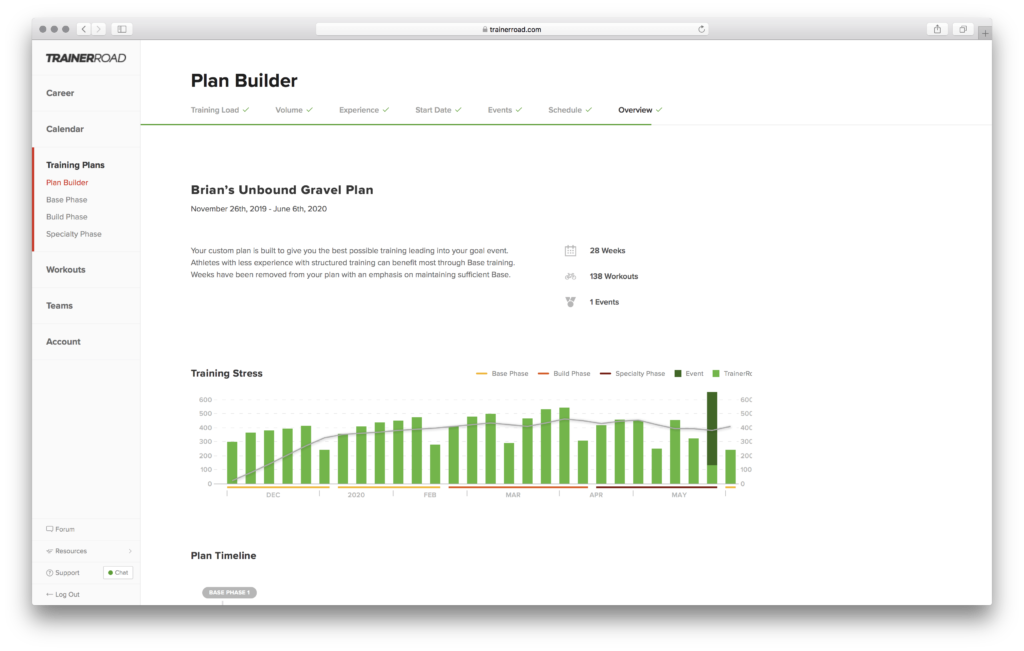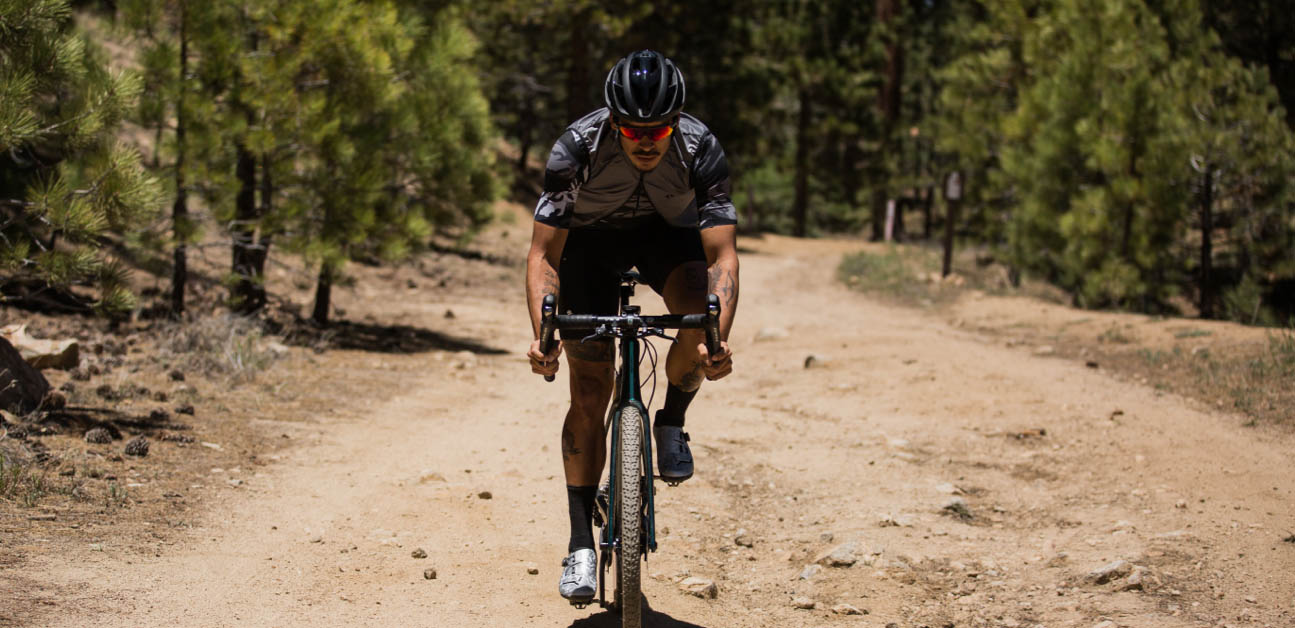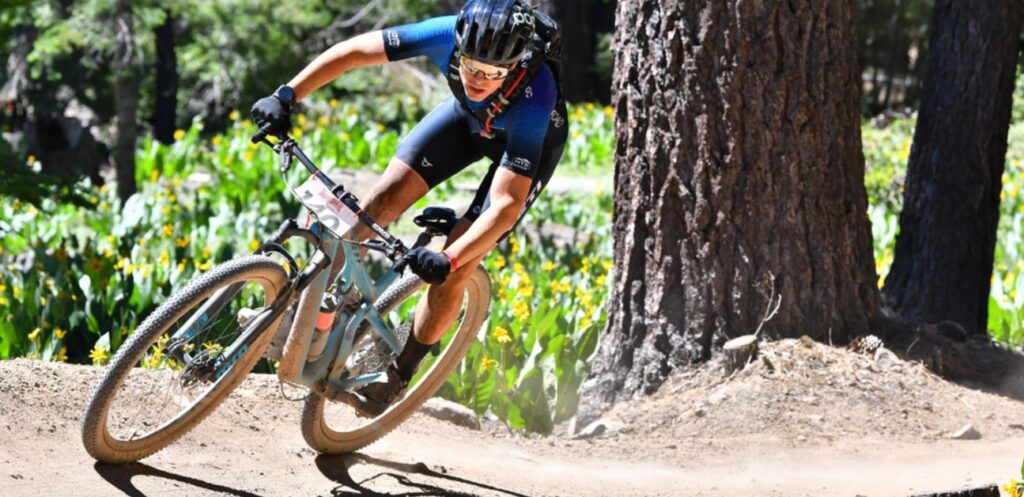With the right training plan, skills, and equipment, you can take on any gravel race. Here’s everything you need to prepare for your next gravel event or your first big gravel race.
What is a Gravel Race or a Gravel Grinder?
Gravel races, also known as gravel grinders, are cycling endurance events similar to road racing, but with one key difference. Instead of taking athletes onto the pavement, gravel races route athletes through a series of unpaved, gravel, and dirt roads. With a lower average speed than a road race but similarly long distances, these mass-start events offer cyclists a whole new way to test their limits.
Adaptive Training
Get the right workout, every time with training that adapts to you.
Check Out TrainerRoadGravel races come in all shapes and sizes, with categories, distances, and events for every athlete. While gravel races are best known for their long distances and grueling demands, a lot of what makes gravel racing popular is the sheer size of the events and the accessibility for all levels of ability and experience. Whether you’re looking to be competitive in your age group or you want to tackle a distance you’ve never ridden before, gravel racing is a great way to test yourself.
Popular Gravel Races
Gravel racing’s popularity has grown exponentially in the past few years, and with it, so have the opportunities for racing. Popular gravel races in the US attract hundreds if not thousands of athletes each year, and with new events continuing to pop up, athletes have a lot of options to choose from. Unbound gravel, Barry Roubaix, The Mid South, and Crusher and the Tushar are among the most popular destination gravel races in the United States.
Unbound Gravel
While most gravel races cap their longest distance off at about one hundred miles, Unbound Gravel gives athletes a chance to race a two hundred mile event through rolling gravel roads in Kansas’s flint hills. You don’t have to race two hundred miles to participate in Unbound gravel, though. The event also offers one hundred, fifty, and twenty-five-mile categories.
Barry Roubaix
The Barry Roubaix is considered to be the largest gravel race in the world. The one hundred mile rolling course in Hastings, Michigan, is characterized by its challenging climbs and varied terrain. With the race scheduled in October, competitors also face a genuine possibility that they’ll be racing in some snow and ice.
The Mid South
If you’re looking for one big adventure loop on red dirt roads, then the Mid South race is perfect for you. This one hundred mile race is a single loop with over four thousand feet of elevation gain. Famous for its red dirt, this spring race has also faced the possibility of inclement weather with rainy day conditions on multiple occasions, turning the dirt roads into sticky mud.
Crusher in the Tushar
The Crusher in the Tushar takes gravel racing to Utah’s Tushar mountain range. This point to point gravel race consists of two long climbs, both top out over ten thousand feet above sea level. After seventy miles of racing, athletes will have accumulated over ten thousand feet of elevation gain.
Typical Gravel Race Courses
As you can see from these four races alone, gravel courses can vary greatly in distance, conditions, terrain, and even the amount of unpaved roads. With that said, most gravel races share a few common variables.
Instead of a lap format, most races are one long loop, point to point, or out and back course. Gravel races also tend to have a solid amount of elevation gain with either lots of short and repetitive climbs or several long sustained ones. The Crusher in the Tushar course is a good example of a more sustained gravel course, while Barry Roubaix is an excellent example of a varied and repetitive course. Gravel races are also usually on the longer side.
Gravel Racing Training
- The distance, structure, and variable terrain of gravel grinders require a solid aerobic base, sustained power capabilities, and varied anaerobic and neuromuscular capabilities.
- You can build your own custom Gravel Grinder training plan with Plan Builder.
What type of fitness do you need for Gravel Racing?
Gravel grinders are first and foremost endurance events. You’ll need strong foundational fitness, a robust aerobic engine, and solid muscular endurance to maintain a high output over a prolonged period of racing.
The climbs, rolling efforts, and general variability of gravel racing will also call for higher and more specialized sustained power abilities. With well-developed sustained power abilities, on top of an already concrete endurance, you’ll be able to attack climb after climb.
To round out your gravel fitness, you’ll also need specific anaerobic and neuromuscular capabilities in order to be able to follow attacks, surge, and ride through variable course conditions.
Gravel Training Plan
These specific capabilities can all be trained with the right Base, Build, and Specialty training progression. The Base Phase addresses your aerobic fitness and establishes your muscular endurance with workouts that gradually challenge your aerobic abilities and progressively increase your ability to hold sustained power.
The Build Phase is where your newly established aerobic fitness is built up and fine-tuned for climbing, racing, and conquering big days in the saddle. In Build, you’ll also increase your Functional Threshold Power, so you can do even more work.
Finally, the Specialty Phase will take the aerobic and anaerobic power built during Build and Base and fine-tune it for the specific type of gravel racing you want to do. The workouts below are examples of how these capabilities can be trained with structured intervals, adjusted to your Functional Threshold Power.
Example Gravel Workouts
Tallac +4 targets improvements in muscular endurance and builds power for the variable, yet sustained grade of gravel climbs. This workout is two hours of sweet spot structured to improve your ability to resist fatigue at high, subthreshold percentages of FTP, over substantial lengths of time.
Mitchell is a VO2Max workout found in the Short Power Build Plan. VO2max workouts, like Mitchell, generally target your aerobic power, pain tolerance, muscular recruitment, and muscle endurance with a whole lot of repeats. If you’re training for a course like the Berry Roubaix, with lots of short, punchy climbs, workouts like these will refine your capabilities for this type of riding.
Wright Peak -1 brings your power close to FTP to increase muscular endurance and repeatability. In a workout like this, you can bring about all of the performance-enhancing adaptations that come as a result of riding at your FTP but with a bit less stress on your muscles and mind.
How TrainerRoad Will Make You a Faster Gravel Racer
With a science-based, structured training plan built for you and your goals, TrainerRoad will make you a faster gravel racer. You can use Plan Builder to build your custom training plan structured specifically for your goal event. Just add your races to your calendar, and Plan Builder will fill in the optimal training sequence based on your priority event, your experience with interval training, and your availability to train.

Once your custom training plan is built, you’ll have the freedom to choose how you want to get faster and what races you want to add along the way. You can take workouts outside on your gravel bike using outside workouts or train indoors on a stationary trainer. You can add or remove races to your calendar at any time or use the training Calendar to adjust workouts. Along the way to your priority event, you’ll raise your FTP, sharpen your capabilities, and reinforce your endurance to become a more well rounded and capable competitor.
Gravel Racing Skills
With outside workouts, it’s also easy to add gravel skills training to your preparation and routine. Whether you’re a beginner gravel racer or an expert in the field, you can use these tips and skills to prepare for your next race.
Technical Skills
Though gravel racing is not inherently technical, the speed and traction on most unpaved roads can make gravel into dangerous terrain. Especially during a race when you’re fighting off fatigue, pushing your limits, and managing traffic around you.
A great way to improve your technical gravel skills is to take some of your workouts outside with outside workouts. Doing this frequently will give you a good feel for your bike and improve your overall confidence on gravel. With that said, it’s also a good idea to work in a few gravel skills drills like descending and cornering on gravel. Even if you’re a skilled technical rider, the occasional set of drills will reinforce important foundational skills.
Gravel Skills Drills
- Range of Motion Drill: In a flat grassy area, try leaning as far forward and as far back as you can over the bike. This allows you to get a feel for the range of motion you actually have on your bike. Way-back lean translates to steep downhills, and way-forward lean translates to steep uphill’s.
- Ratcheting Practice: Playing around with some ratcheting drills is a great way to make ratcheting second nature during races where rocks and other obstacles don’t always offer enough clearance. To practice, try maintaining forward movement on a flat plane without pedaling in complete circles.
- Bunny-Hopping: Being able to lift your front or back tire effortlessly, or even both, can help give you better control over your bike. To practice, repeatedly lift the bike’s front end in one set of drills and the back end of the bike in another set. When you’re confident doing them separately, try putting them together to clear a rolled-up towel (the towel is a good low-risk obstacle for practice).
- Traction Drills: A great way to maintain traction on loose terrain is to practice pedaling while braking.
Gravel Bike Setup and Equipment
Though there are advantages to using a gravel-specific bike, not having a gravel bike doesn’t exclude you from racing most gravel races. In fact, if you’re someone who hasn’t spent much time riding a drop-bar bike off-road, a mountain bike with gravel tires might be the better choice. If you’re planning on racing another type of off-road bike, just be sure to check the regulations at your event to make sure your bike meets the safety requirements.
That said, there are several advantages to a gravel-specific bike. Gravel bikes can vary greatly between manufactures, but there are plenty of similarities. The frame geometries are usually more upright to provide comfort for long days in the saddle, while providing stable steering with slack front-ends.
Gravel bikes also feature plenty of tire clearance. Because gravel races can differ in the amount and roughness of the gravel, optimal tire choice will differ as well. For some races, a 35mm wide tire will do, but a 40mm or wider will be best for others. To have the most available tire options, you’ll want a frame that can clear a 42mm tire at a minimum.
If you do plan on racing a gravel-specific bike on race day make sure you get lots of practice riding on the equipment you’re going to race with. Gravel bikes offer a sturdier, lighter, and more comfortable alternative to other options, but they’re only as good as you are comfortable handling them.
Gravel Bike Setup Tips
- Go Tubeless: Tubeless tires can save you from needless stopping and avoid pinch flats while running a lower tire pressure. Just be sure to carry an extra tube and plug kit just in case.
- Wide-Range Gearing: Gearing for gravel will depend on your events and the type of riding you do. You can go 1x or 2x, but just make sure you have enough low gears, so you don’t have to grind at a low cadence all day.
- Extra Mounts: Most gravel bikes come with extra mounts on the frame to attach extra bottles and bags. With so many ultra-distance events, carrying a third bottle can be very helpful.
- Contact Points: Make sure you dial-in your contact points (shoes, saddle, and bars) for all-day comfort. Try to do at least one long ride to test and experiment because something that’s comfortable during a one-hour ride could be painful four or five hours in.

